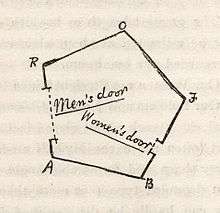Mathematical fiction
Mathematical fiction is a genre of creative fictional work in which mathematics and mathematicians play important roles. The form and the medium of the works are not important. The genre may include poems, short stories, novels or plays; comic books; films, videos, or audios. One of the earliest, and much studied, work of this genre is Flatland: A Romance of Many Dimensions, an 1884 satirical novella by the English schoolmaster Edwin Abbott Abbott. Mathematical fiction may have existed since ancient times, but it was recently rediscovered as a genre of literature; since then there has been a growing body of literature in this genre, and the genre has attracted a growing body of readers.[1][2] For example, Abbot's Flatland spawned a sequel in the 21st century: a novel titled Flatterland, authored by Ian Stewart and published in 2001.

A database of mathematical fiction
Alex Kasman, a Professor of Mathematics at College of Charleston, who maintains a database of works that could possibly be included in this genre, has a broader definition for the genre: Any work "containing mathematics or mathematicians" has been treated as mathematical fiction. Accordingly, Gulliver's Travels by Jonathan Swift, War and Peace by Lev Tolstoy, Mrs. Warren's Profession by George Bernard Shaw, and several similar literary works appear in Kasman's database because these works contain references to mathematics or mathematicians, even though mathematics and mathematicians are not important in their plots. According to this broader approach, the oldest extant work of mathematical fiction is The Birds, a comedy by the Ancient Greek playwright Aristophanes performed in 414 BCE. Kasman's database has a list of more than one thousand items of diverse categories like literature, comic books and films.[3][4][5]
Some works of mathematical fiction
The top ten results turned up by a search of the website of Mathematical Association of America using the keywords "mathematical fiction" contained references to the following works of mathematical fiction.
- Alex Kasman (2005). Reality Conditions: Short Mathematical Fiction. Mathematical Association of America. p. 250.
- Gaurav Suri; Hartosh Singh Bal (2007). A Certain Ambiguity: A Mathematical Novel. Princeton University Press. p. 304. ISBN 9780691127095.
- Chandler Davis, Marjorie Wikler Senechal, and Jan Zwicky, editors (2008). The Shape of Content: Creative Writing in Mathematics and Science. A K Peters. p. 194. ISBN 9781568814445.CS1 maint: multiple names: authors list (link)
- William Frucht (1999). Imaginary Numbers: An Anthology of Marvelous Mathematical Stories, Diversions, Poems and Musings. John Wiley. p. 352. ISBN 978-0471332442.
- Denis Guedj (2002). The Parrot's Theorem: A Novel. St. Martin's Griffin. p. 360. ISBN 978-0312303020.
- Philibert Schogt (2000). The Wild Numbers. Four Walls Eight Windows. pp. 160. ISBN 978-1568581668.
References
- Janice Padula. "Mathematical fiction for senior students and undergraduates: Novels, plays, and film" (PDF). Australian Senior Mathematics Journal. 20 (2): 36–44. Retrieved 26 April 2016.
- Darren Glass. "MAA REview of The Shape of Content: Creative Writing in Mathematics and Science". Mathematical Association of America. Retrieved 28 April 2016.
- Alex Kasman. "Mathematical Fiction". Alex Kasman. Retrieved 26 April 2016.
- "Mathematical Fiction Website Achieves Milestone". American Mathematical Society. Retrieved 1 May 2016.
- Maya Sharma. "Stories for Mathematicians: The Mathematical Fiction Homepage". AMS Blogs. American Mathematical Society. Retrieved 1 May 2016.
Further reading
- For a study of the mathematical fiction for senior students and undergraduates see: Janice Padula. "Mathematical fiction for senior students and undergraduates: Novels, plays, and film" (PDF). Australian Senior Mathematics Journal. 20 (2): 36–44. Retrieved 26 April 2016.
- For a selection of mathematical fiction chosen with the teaching of mathematics in secondary school in mind: Janice Padula (2005). "Mathematical Fiction: Its Place in Secondary-School Mathematics Learning" (PDF). Australian Mathematics Teacher. 61 (4): 6–13. Retrieved 26 April 2016.
- For a discussion of the portrayal of mathematicians in fictional works: Daniel Dotson (2006). "Portrayal of Mathematicians in Fictional Works". CLC Web: Comparative Literature and Culture. 8 (4). Retrieved 26 April 2016.
- For an analysis of mathematical fiction with geometrical themes see: Jennifer Rebecca Shloming (2012). Analysis of Mathematical Fiction with Geometric Themes. Columbia University. Retrieved 26 April 2016.
- For a review of Flatterland: Jody Trout (April 2012). "Review of Flatterland: Like Flatland, Only More So" (PDF). Notices of the AMS. 49 (4): 462–465. Retrieved 30 April 2016.